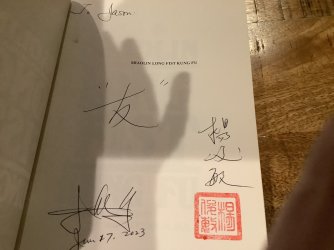OP
Wing Woo Gar
Senior Master
- Thread Starter
- #21
It actually doesn’t require much strength at all. Angles, that’s all. Dr Yang says it over and over again, no force, just angle. When I successfully sink these level 1 locks it feels effortless.I'm currently only doing the conditioning and strength exercises but haven't done any of the techniques yet. My grip was never as strong as it needs to be in order to pull a lot of the techniques off. I think once I get to an acceptable level, then I'll start working on the techniques while improving my strength. I'm currently using a 10lb slam ball to strengthen my grip and hopefully I can move to a 15lb slam ball before the end of the year. Recently I picked up the 10lb ball and thought it was the 8lb ball. I'm getting stronger but I'm not sure if I'm ready for a 5lb jumb in weight. 15lbs may be a bit too heavy and then there's the question of what should the stopping point be.
I'll probably try some techniques on the muay thai guy that comes in to work on the speed bag. I won't know how much stronger my grip truly is until I give it a try during sparring.


